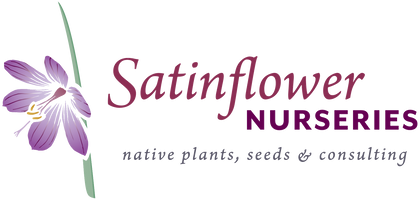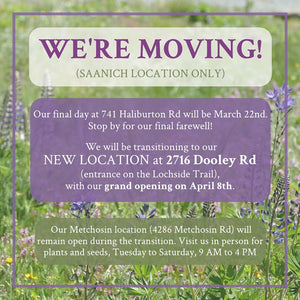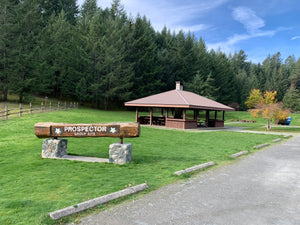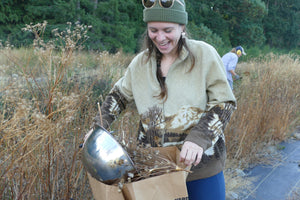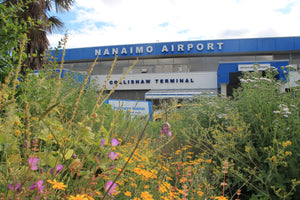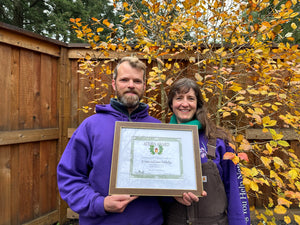The YCD Pollinator Garden: A Living Welcome to Nanaimo’s Native Flora and Fauna

Whether local or visitor, the moment you step out the front doors of the Nanaimo airport, you will be greeted by the native flora of our region at the YCD Pollinator Garden. The native plant garden provides a warm welcome to the region, showcasing an array of native species. This Pollinator Garden has encouraged travellers to connect with nature and inspired employees to learn more about native plants, pollinators and local ecosystems.
Collaboration and Transformation:
Laurie Hawthornthwaite and Keith Granbois have been key leaders in bringing this project to life. Standing on the garden’s edge on a sunny spring morning, Laurie shares that the entire airport staff was on board from the very beginning, creating a supportive community and a strong foundation for the project. The Nanaimo airport staff collaborated with Pollinator Partnership and Sainflower Nurseries to create an ecologically functional habitat and help educate visitors. Before the YCD Pollinator garden was installed, the space was filled with ornamental, non-native plants that offered little benefit to the local fauna and ecosystem.

Pollinators buzz on Woolly Sunflower and Farewell-to-Spring
Nurturing Patience: Growth and Change
After the initial installation, the small plants needed time to grow, which led some visitors to question the vision for the space, as it wasn’t yet as lush and full as a mature garden. Watching the space evolve through the many phases of growth has shifted perspectives and underscored the importance of stewardship as an ongoing relationship. Now in its third season, the space has blossomed into a vibrant habitat and is regularly maintained by Satinflower Nurseries and airport volunteers. Laurie shares that her favourite part of the garden has been witnessing "all the buzzing" of bees and other pollinators, a sign of the diverse ecosystem they have created. The transformation has been rapid in her eyes, both in the garden's growth and the interactions it has inspired among people.

Bumblebee on Sticky Cinquefoil
Biodiversity and Impact
Pollinator Partnership has conducted several surveys on the site to evaluate the garden's role in supporting biodiversity and its overall ecological impact. All results have shown that native pollinators preferred the native flora. One of the studies, conducted in 2022, found that 96% of the bees were observed in the pollinator garden despite being surrounded by ornamental garden beds full of blooming non-native flowers. In 2022, 137 native bees were recorded happily collecting pollen in the native gardens, while only 6 were found in the ornamental beds with the same observation time.
Some of the native plant species that can be found in this garden are:
- Achillea millefolium “Yarrow”
- Allium cernuum “Nodding Onion”
- Cerastium arvense “Field Chickweed”
- Clarkia amoena “Farewell-to-Spring”
- Cornus sericea ssp. sericea “Red-osier Dogwood”
- Festuca roemeri “Roemer's Fescue”
- Grindelia stricta “Entire-leaved Gumweed”
- Heuchera micrantha “Small-flowered Alumroot”
- Koeleria macrantha “Junegrass”
- Plectritis congesta “Sea Blush”
- Symphyotrichum chilense “California Aster”
- Tellima grandiflora “Fringecup”
And many more!

Small-flowered Alumroot Blooms
As the garden continues to grow, the number of pollinators observed in the space has also increased. In 2023, 487 bees were recorded in the gardens over the two sample days (the same dates as the previous year). That year, 481 (98%) of the bees were found in the pollinator garden and only 6 in the ornamental garden beds. As the plants continue to increase in maturity, larger floral displays and diversity can support larger numbers of pollinators.
In the 2023 Pollinator Partnership survey of the YCD gardens, Lora Morandin notes:
“Bee populations build up over time when there is pollinator-supporting habitat—the bees utilizing the habitat in 2022 likely were able to lay more offspring that were then evident in the substantially larger native bee abundance in 2023. As the garden continues to mature, we expect that the bee abundance will continue to increase, but then reach a steady level of abundance supported by the garden resources”.

Indoor Educational Display
Native Plants and Pollinators: A Vital Relationship
Native plants in this region have evolved to attract pollinators and provide ideal conditions for them to support their mutualistic relationship. Non-native pollinator-friendly flowers do not necessarily provide adequate pollen or meet all of the needs of the pollinators native to this region. Many pollinators are picky about their preferred flowers due to their specific pollen and nectar needs. When specific food sources are removed from the landscape, the species that depend on them are at risk. Hosting a diversity of native bees is characteristic of a natural, healthy, and resilient ecosystem.

Signage in the Garden
Coexisting with Bees in Public Spaces
Before installation, some raised concerns about the garden attracting bees in a high-traffic area, which could deter passersby from approaching. However, YCD staff have observed the opposite effect: instead of avoiding the garden, people are drawn to it, eager to learn more and appreciate its beauty. There have been no reports of stings or any negative experiences with the garden whatsoever, only positive feedback. Native bees and other native pollinators are quite docile and only interested in flowers. Informational panels inside the terminal provide additional insights, encouraging a deeper understanding and appreciation of native bees and other pollinators.

Fly Nectars on Sticky Cinquefoil
Expanding Inspiration: The Garden’s Broader Impact
The garden's success has sparked interest in transforming surrounding ornamental garden beds into native plant gardens to create more pockets of habitat. This enthusiasm has extended beyond the airport, as staff and visitors alike have been inspired to bring similar native plant projects into their own homes. It has also fostered a sense of community, with dedicated volunteers stewarding the space and ensuring its continued success. The YCD Pollinator Garden has transformed the airport into a place where nature and human activity harmoniously coexist, providing an island of habitat for pollinators and a moment of tranquillity and inspiration for all who pass by.

Educational display inside the terminal.
- Tags: AirportGarden pollinatorgarden YCD
- Satinflower Nurseries
